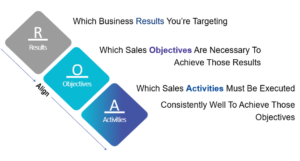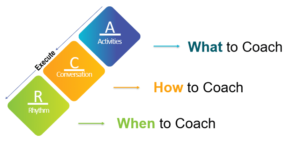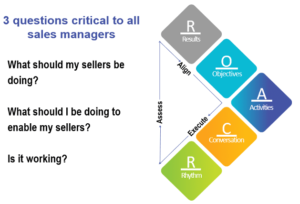The Sales Management Code Defined

Is there a decision-making framework that the highest performing sales managers employ? How do the highest performers prioritize their effort, allocate their coaching most effectively, and measure salesperson progress toward quota? Is there a sales management training program that teaches these vital skills?
The answer to these questions is yes. There is a code that the most successful sales managers use to manage, coach, and measure their sales teams. It is a framework for good decision-making that leads to targeted and effective sales execution. Managers in our research who use this Sales Management Code get 35% more of their salespeople to quota compared with managers who take a more ad-hoc approach to sales management.
This decision-making framework is so vital that our continued research into sales manager and sales leader effectiveness has led us to conclude that this Code is the key to organizational sales agility. It is the set of decisions that enable sales managers and leaders to make direct connections between marketplace realities, organizational objectives, and sales execution. Sales leaders who display the highest levels of organizational agility are able to make timely and meaningful adjustments to the following vital decisions:
- Of all the activities my salespeople could be executing, which ones are the most high-impact and linked to the desired organizational outcomes?
- How do I best coach my salespeople to ensure consistent and effective execution of the highest-impact activities?
- How do I know if the sales execution and coaching is moving the right levers, to the right degree, in the right direction?
To put these three questions in their simplest terms, the Sales Management Code framework enables managers to answer three vital questions:
- What should my salespeople be doing?
- How can I best enable them?
- Is it working?
These are the three most important questions sales managers must answer and act upon to get the largest percentage of their salespeople to quota. Let’s unpack these questions one at a time to get a fuller understanding of this Sales Management Code.
What Should My Sellers Be Doing?
This first question, the first part of the Sales Management Code framework, is vital for creating clarity of task for salespeople. Clarity of task is defined as the direct connection between the actions you are asking salespeople to perform, and the outcomes you are holding them accountable to achieve. It answers the question “How can I hit my quota – what do I have to do?” Every salesperson wants to succeed. Every sales manager wants their sellers to succeed. This first question is the foundation for organizational alignment and agility in connecting seller activities to organizational goals. Here’s how it works:

By making this direct connection – or alignment – between results (R), objectives (O), and activities (A) – managers can prioritize seller effort toward those sales activities that are most critical and high impact. Clarity of the sales task accounts for over 30% of the variance in salesperson motivation. You want your sellers to execute the right things? You want to maintain high retention of sales talent? Create clarity of task with the proper alignment! What do you do next? Well, that is all about enablement.
How Do I Best Enable My Salespeople?
The highest-performing sales managers know they can’t coach everything. There just isn’t enough time. So, how do these high performers decide what to coach? They coach the sales activities that are the most important, the highest impact. The ones identified in the first part of this framework, the alignment portion. When sales managers can isolate the few seller activities that have an outsized impact on seller performance, they can orient their coaching toward those activities. How do sales managers coach most effectively to high-impact activities? In a management rhythm of structured coaching conversations. A sales management rhythm is the pattern of formal and informal interactions a sales manager engages in to achieve sales targets. The manager’s rhythm of coaching should be oriented around a few high-impact sales activities.
Once the most critical sales activities have been identified, high-performing managers determine the right structure to coach each activity. This structure includes inputs, agendas, and outputs for each coaching conversation. Sellers and managers both prepare for the coaching conversation. A tight agenda is developed that dives deeply into a few key topics and ensures accountability of next actions.
Finally, the sales manager determines the right rhythm of coaching for each high-impact activity. What is the right frequency of coaching for each activity? What is the desired or best duration for each coaching conversation? Once the manager has:
- Determined the best high-impact activities for coaching
- Structured the coaching conversations to ensure the right topics and depth
- Determined the right frequency and duration of coaching for each activity
The highest performing sales managers connect the dots between:

The above actions provide the most direct and effective path to coaching that gets results. These items form the basis of the “execution” portion of the Sales Management Code by codifying what managers should be coaching, how, and when. Once this structure is put in place, the next element of the Sales Management Code framework enables managers to stay on top of performance and make necessary adjustments.
Is It Working?
The only reason to identify alignment between business results (R), sales objectives (O), and sales activities (A) is to know which metrics need to be moving in which direction to indicate progress. For example, if one of my sales objectives is to target certain segments of customers, then my seller’s pipelines should reflect deals that involve the desired customer segment. If one of my sales objectives is to sell a certain product mix, then deals in my seller’s pipelines should reflect the right mix of products. In other words, to acquire new customer segments, I need deals in the pipeline that reflect the desired segments. Those deals act as leading indicators of whether the activities a sales manager has identified as high impact are having the desired effect.
If the right sales objectives and KPIs are trending in the right direction, I know that the alignment and execution are working. If not, I must make adjustments in the activities sellers are executing, the rhythm of coaching I’m providing, or both. This assessment part of the Sales Management Code framework keeps managers and sellers on the right track to achieve targeted objectives and KPIs.

The closed-loop decision-making framework embedded within the Sales Management Code enables sales managers to make the best decisions regarding salesperson execution, sales coaching, and indicators of progress. The Sales Management Code equips sales managers with the most critical decision-making skills to lead more of their salespeople to quota.
Our Offerings
The Sales Management Code™ equips sales managers with a simple, yet powerful framework for aligning seller and manager effort to desired business results, coaching in ways that drive maximum impact, and assessing leading indicators of progress to determine if sellers are on the right path to quota.
The Pipeline Coaching Code™ equips sales managers and leaders with a powerful framework for assessing the health of the pipeline, considering size, contents, and progress. It then equips managers to make deliberate decisions about how to ensure the health of the pipeline and the viability of deals within the pipeline. Managers will reorient effort toward the early stages of deals to improve deal viability and velocity.
VantagePoint Performance is now part of Imparta, a global leader in performance improvement for customer-facing teams.